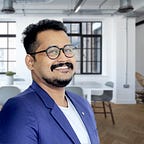My process of validating big challenges and ideas.
Hi, I’m Rajesh Kattambally, a Product Designer and design sprint facilitator from Bangalore. I am currently working at Bizlee as a Lead product designer and project manager. I was formerly the Co-founder and Creative director at Corediary and before that, I was working as an email designer and web designer for a couple of other companies and clients.
A product designer is a problem solver and is more empathetic towards real user issues. My goal is to help the rest of the team understand our users’ problems and business objectives clearly and help in designing solutions that are useful, monetizable, elegant, simple, and enjoyable to use.
What’s more, I believe designers are only truly valuable when we deliver projects holistically and collaboratively with the help of the google design sprint kind of process, where each team member becomes cross-functional.
I follow and facilitate a design sprint framework that validates ideas and solves big challenges with a high level of team collaboration!
To achieve that, I follow this process
1. lightning decision jam
In almost all the project’s initial stages I have faced difficulty in unproductive, open, and useless discussions with the team and stakeholders.
I use the Lightning decision jam technique to align the team towards a common set of goals and agreed-upon solutions.
“It’s important that we are all on the same page before diving in”
This technique helps to :
- Easy to make faster decisions.
- Prioritize problems by team’s silent votes.
- Find feasible and creative solutions to voted problems.
- Decide the solutions/features to work on next by Effort impact graph.
2. Understand the Challenges
Understanding real challenges from stakeholders and experts are really important for the success of the project. These steps will align the team towards a common goal/problems/design challenges/strategy to solve problems within 5 days.
That involves:
- Expert interviews +HMWs
Interview experts on your sprint team and guests from the outside. Ask about the vision, customer research, how things work, and previous efforts. Pretend you are a reporter. Update long-term goals, questions, and maps as you go.
frame the problem as opportunities. Start with the letters HMW on the top left corner. Write one idea per sticky note. Make a stack as you go. Organize how might we note and Vote on how might we note
- Long term goal
- Sprint questions
- user journey map
- Target — sprint focus
With these first-day steps, the team will get aligned to a common goal/problems/design challenges/strategy to arrive at the solution. Research the target audience
- Research existing solutions and competitors
Key Business Advantage: Ensures better product-market fit
Depend on the project I have used Product definition canvas (twg).
2. Ideate
In this phase, the entire team (ideally 7 -10 people with diverse skills and expertise ) will come up with individual solutions to the original design challenge
.Outcome of this phase will be
Lightning demos
Solution sketches (Crazy 8’s and solution sketch)
3. Decide
In this phase, the team individually come up with solutions and decide solutions to prototype by:
Vote on solutions (Heat map vote, Solution presentation, Strawpoll vote, and decider vote).
User test flow
Storyboarding
4. Prototype
This phase is my favorite and exciting as a product designer! the reason behind making a high-fidelity prototype is to validate the overall product idea/challenges/ and get the answers to the sprint questions.
- High fidelity prototype
Tools used: Adobe xd, Invision, Trello
Build a prototype that looks real enough to the test it out with the user.
5. User testing
I have done mainly In-person testing and remote testing.
Tools used: Real time board (mirro), Google meet, Cameras, Mobiles, Tripod/recording stand, Video recording, Video streaming,Earphones, Notebooks, Sticky notes(Green & Orange).
Recruiting user testers (target 5 users).
Ask questions to qualify the testers by Survey platforms . (google forms, survey monkey).
Prepare interview questions and NDS(tasks based)
Conduct interview.
Give some time to finish all the tasks then ask :
- What do you think of this(specify any of the tasks)
2. What do you expect that will do(specify a task)
3. What are you looking for(specify a task)
To wrap up the interview
- How does this app feel with what do use now?
2.What did you like about this?
3. What did you dislike?
4. How can you describe this to your friends?
5. Anything more to tell us about the app.
6. In the existing app/services, did you face any difficulties? What are they?
Deliverables
- High fidelity prototype
- Detailed user test feedback and feature requests.
- Recommendations by effort impact scale.
- Design sprint summary document.
You can have a look at my Instagram stories and posts about my process here.
Let me know what user-centric process you follow and make team more collaborative by leaving your comments below.
Thank you for reading! If you enjoyed my process have any feedback, I’d love to hear from you. You can give your response to this post below or email me at rajcreation.designs@gmail.com
